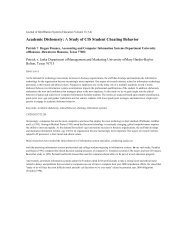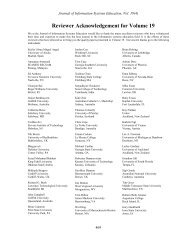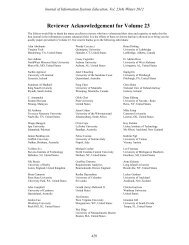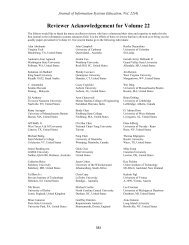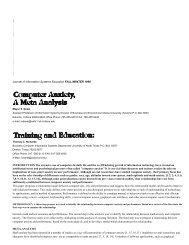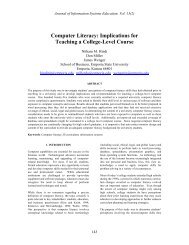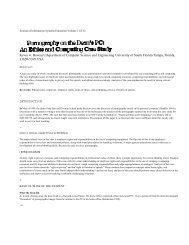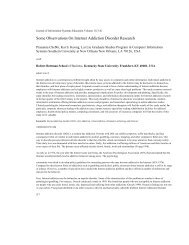Writing IS Teaching Tips - Journal of Information Systems Education
Writing IS Teaching Tips - Journal of Information Systems Education
Writing IS Teaching Tips - Journal of Information Systems Education
You also want an ePaper? Increase the reach of your titles
YUMPU automatically turns print PDFs into web optimized ePapers that Google loves.
2. BACKGROUND<br />
The sharing <strong>of</strong> educational improvements through<br />
acknowledged academic journals is not unique to the<br />
information systems discipline. Our business colleagues in<br />
management, marketing, and accounting have a substantial<br />
history <strong>of</strong> publishing work related to improving the quality<br />
<strong>of</strong> education in each <strong>of</strong> these disciplinary areas. More<br />
recently, educators in the decision sciences area have also<br />
gained a discipline-specific journal for educational-focused<br />
resources. A sampling <strong>of</strong> such disciplinary-specific journal<br />
outlets includes: Issues in Accounting <strong>Education</strong>, <strong>Journal</strong> <strong>of</strong><br />
Accounting <strong>Education</strong>, <strong>Journal</strong> <strong>of</strong> Management <strong>Education</strong>,<br />
Academy <strong>of</strong> Management Learning and <strong>Education</strong>, <strong>Journal</strong><br />
<strong>of</strong> Marketing <strong>Education</strong>, and Decision Sciences <strong>Journal</strong> <strong>of</strong><br />
Innovative <strong>Education</strong>. In addition to the disciplinaryspecific<br />
journals, there is also the <strong>Journal</strong> <strong>of</strong> <strong>Education</strong> for<br />
Business that indicates it “<strong>of</strong>fers a forum for authors<br />
reporting on new successful teaching methods and<br />
curricula,” (<strong>Journal</strong> <strong>of</strong> <strong>Education</strong> for Business website, 2012)<br />
though recent issues did not show evidence <strong>of</strong> such<br />
published work. In most <strong>of</strong> these examples, published<br />
resources aimed at improving the quality <strong>of</strong> general business<br />
or disciplinary-specific education included: a description <strong>of</strong><br />
the idea, a theory or practice context for the idea, a detailed<br />
discussion <strong>of</strong> the idea so that others can replicate it, and a<br />
discussion <strong>of</strong> the evidence for the efficacy <strong>of</strong> the idea.<br />
Further, each academic journal provides advice to potential<br />
manuscript authors regarding expected content and<br />
formatting rather than leaving this decision to the operations<br />
<strong>of</strong> the journal’s editorial board.<br />
Although the information systems academic community<br />
has several education-related conferences (e.g., <strong>IS</strong>ECON,<br />
IAIM) and continuing tracks at its major academic<br />
conferences (e.g., IC<strong>IS</strong>, AMC<strong>IS</strong>, PAC<strong>IS</strong>, EC<strong>IS</strong>) and several<br />
regional conferences (e.g., Midwest A<strong>IS</strong>, Southern A<strong>IS</strong>),<br />
there are few permanent, easily accessible, and dedicated<br />
repositories for information systems instructional<br />
improvements. The Association for <strong>Information</strong> <strong>Systems</strong><br />
website has attempted to provide access to useful and<br />
academically-reviewed teaching resources, though this effort<br />
has been coordinated through a network <strong>of</strong> volunteers and<br />
has proven difficult to maintain over time. Past resources<br />
were hosted at Grand Valley State University through the<br />
efforts <strong>of</strong> Dr. Simha Magal; a current initiative by A<strong>IS</strong>-<br />
SIGEd/IAIM volunteers is still in process. J<strong>IS</strong>E provides<br />
one <strong>of</strong> the few archival, academic, peer-reviewed journal<br />
outlets for such teaching and learning scholarship focused on<br />
the information systems area.<br />
<strong>Teaching</strong> <strong>Tips</strong> submitted to J<strong>IS</strong>E have reported on many<br />
different types <strong>of</strong> improvements. Some are project-based and<br />
suggest assignments for a specific course or courses (e.g.,<br />
Chen & Brabstone, 2010 or Liu & Downing, 2010). Some<br />
introduce a technique that can be used in a number <strong>of</strong><br />
courses (e.g., Whisenand and Dunphy, 2010). Some<br />
introduce a technology (e.g., Dunlap & Lowenthal, 2009). In<br />
this section we provide an overview <strong>of</strong> what makes a<br />
<strong>Teaching</strong> Tip a <strong>Teaching</strong> Tip and what makes it suitable for<br />
publication in J<strong>IS</strong>E. We also discuss the purpose <strong>of</strong><br />
publishing <strong>Teaching</strong> <strong>Tips</strong> in J<strong>IS</strong>E and the motivation for<br />
writing a <strong>Teaching</strong> Tip.<br />
<strong>Journal</strong> <strong>of</strong> <strong>Information</strong> <strong>Systems</strong> <strong>Education</strong>, Vol. 23(1)<br />
2.1 What makes a <strong>Teaching</strong> Tip a <strong>Teaching</strong> Tip?<br />
We first must distinguish a <strong>Teaching</strong> Tip submission from<br />
other types <strong>of</strong> articles published in J<strong>IS</strong>E. Weimer (2006)<br />
provides a helpful dichotomy <strong>of</strong> scholarship in the teaching<br />
and learning field by categorizing such scholarship as either<br />
being wisdom-<strong>of</strong>-practice scholarship or research<br />
scholarship. Wisdom-<strong>of</strong>-practice scholarship is based upon<br />
experience in instruction. Weimer (2006) calls this the howto-literature<br />
<strong>of</strong> teaching. <strong>Teaching</strong> <strong>Tips</strong> fall into this<br />
category. Research scholarship is a more typical type <strong>of</strong><br />
scholarly research using quantitative, qualitative, or<br />
descriptive forms <strong>of</strong> research. In this type <strong>of</strong> scholarship,<br />
surveys and experiments on information systems educational<br />
methods are common examples.<br />
The distinction between these two categories is not<br />
always clear. A good <strong>Teaching</strong> Tip includes evidence that<br />
the improvement worked. If that evidence is provided by a<br />
survey, is it still a <strong>Teaching</strong> Tip? The answer to that question<br />
is based upon emphasis. If the emphasis in the paper is on<br />
the teaching and/or learning improvement with a detailed<br />
description <strong>of</strong> the improvement in such a way that another<br />
instructor could adopt or adapt the idea, it falls into the<br />
<strong>Teaching</strong> Tip category. Such a paper would include example<br />
exercises, methods <strong>of</strong> using the idea, and guidance on how to<br />
adopt the idea. On the other hand, if the emphasis <strong>of</strong> the<br />
paper is on the evidence collection and analysis <strong>of</strong> the<br />
evidence, it falls into the research scholarship category and<br />
thus is not a <strong>Teaching</strong> Tip. As an example, contrast two J<strong>IS</strong>E<br />
papers: a <strong>Teaching</strong> Tip, Lending (2010) and a research<br />
paper, Part, et al. (2010). Both papers are about introducing<br />
Wiki technology into a course and both include evidence <strong>of</strong><br />
how it worked. The <strong>Teaching</strong> Tip focuses on how to<br />
introduce a particular Wiki assignment into a course. The<br />
research paper focuses on the methodology and analysis <strong>of</strong><br />
Wiki technology in graduate education outcomes.<br />
Secondly, we must distinguish <strong>Teaching</strong> <strong>Tips</strong> from<br />
<strong>Teaching</strong> Cases. A <strong>Teaching</strong> Case is based upon a real-world<br />
or real-world-type situation. It provides a case that students<br />
can analyze or a problem that they can solve. Cappel and<br />
Schwager (2002) classified <strong>Teaching</strong> Cases into two<br />
different types: non-project-based cases and project-based<br />
cases. The non-project-based cases are discussion-based and<br />
typically provide questions for students to answer. Often<br />
they ask students to take the role <strong>of</strong> a decision-maker in an<br />
organization. Non-project-based cases are used by many<br />
business disciplines and resemble the Harvard or Ivey cases<br />
<strong>of</strong>ten used in advanced undergraduate and graduate business<br />
education. Project-based cases are categorized as "systems<br />
solution cases" (Cappel & Schwager, 2002). In these cases,<br />
students create an information systems solution which may<br />
include models, documentation, or working systems. This<br />
type <strong>of</strong> case is more typical in the information systems<br />
discipline than other business disciplines, as information<br />
systems practitioners are quite active in building such<br />
artifacts for use in organizations.<br />
A <strong>Teaching</strong> Tip may also present a real-world case or<br />
situation to be solved. The distinction between a tip and a<br />
case can be subtle but again is based upon emphasis and<br />
presentation. A <strong>Teaching</strong> Case emphasizes the actual<br />
business problem that you want students to solve. The<br />
published portion <strong>of</strong> a <strong>Teaching</strong> Case describes the real<br />
12



